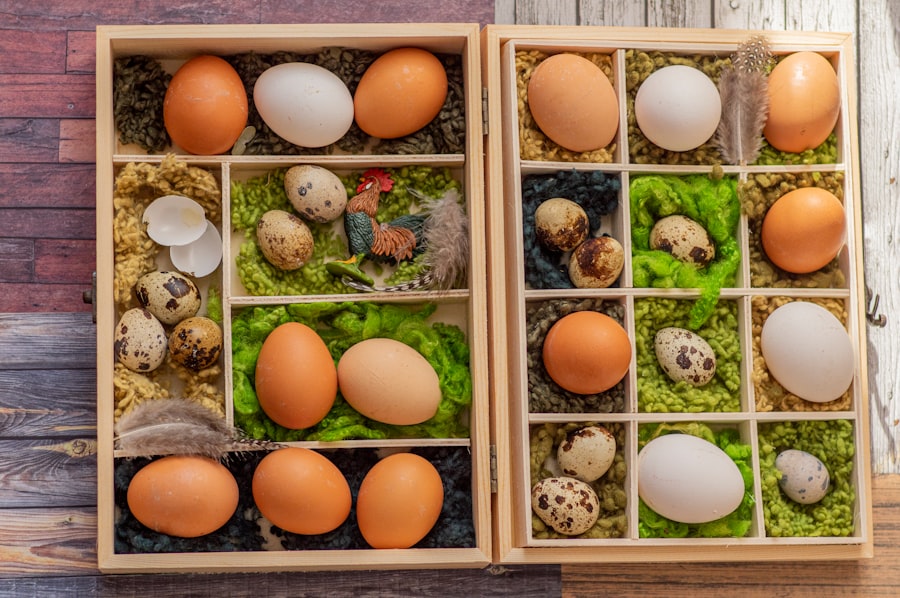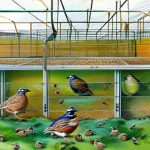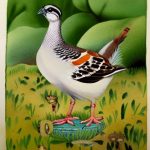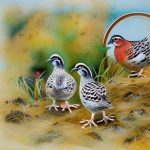Quail breeding experiments are an essential part of research and development in the field of aviculture. Quails are small, ground-dwelling birds that are known for their fast growth and high egg production. They are also relatively easy to care for, making them an ideal subject for breeding experiments. These experiments are conducted to study various aspects of quail genetics, behavior, and physiology, with the ultimate goal of improving quail breeds for commercial production or conservation purposes.
Quail breeding experiments can involve a wide range of variables, including genetic traits, environmental factors, and management practices. Researchers may be interested in studying the heritability of certain traits, such as egg production or disease resistance, or the effects of different diets or housing conditions on quail health and productivity. By carefully designing and conducting breeding experiments, researchers can gain valuable insights into the factors that influence quail breeding success, which can ultimately lead to the development of more robust and productive quail breeds.
Table of Contents
- 1 Selecting Breeding Stock for Quail Experiments
- 2 Setting Up the Breeding Environment for Quail
- 3 Monitoring and Managing Quail Breeding Experiments
- 4 Recording and Analyzing Data from Quail Breeding Experiments
- 5 Challenges and Considerations in Quail Breeding Experiments
- 6 Conclusion and Future Directions for Quail Breeding Research
- 7 FAQs
- 7.1 What is quail breeding?
- 7.2 What are some common traits that quail breeders may aim to produce in their offspring?
- 7.3 What are some common methods used in quail breeding experiments?
- 7.4 What are some factors that breeders consider when conducting quail breeding experiments?
- 7.5 What are some potential challenges in quail breeding experiments?
- 7.6 What are the potential benefits of quail breeding experiments?
Key Takeaways
- Quail breeding experiments involve selective breeding to achieve specific traits in quail populations.
- Select breeding stock based on desired traits, health, and genetic diversity to ensure successful experiments.
- Create a suitable breeding environment with proper housing, nutrition, and lighting for quail to thrive and reproduce.
- Regularly monitor and manage the breeding process to ensure the health and well-being of the quail population.
- Record and analyze data on breeding success, genetic traits, and other relevant factors to draw conclusions and plan future research in quail breeding.
Selecting Breeding Stock for Quail Experiments
Selecting the right breeding stock is crucial for the success of quail breeding experiments. The goal is to choose birds that exhibit the traits of interest and have the genetic potential to pass those traits on to their offspring. When selecting breeding stock, researchers should consider a variety of factors, including genetic diversity, health, and productivity. Genetic diversity is important for maintaining a healthy and resilient quail population, so researchers should aim to select birds from different genetic lines or populations. This can help prevent inbreeding and reduce the risk of genetic disorders.
In addition to genetic diversity, researchers should also prioritize the health and productivity of the breeding stock. Birds should be free from any obvious signs of disease or deformity, and they should have a history of good egg production and fertility. By selecting healthy and productive birds as breeding stock, researchers can increase the likelihood of producing offspring with similar traits. Overall, the selection of breeding stock for quail breeding experiments requires careful consideration of genetic diversity, health, and productivity to ensure the success of the experiments and the welfare of the quail population.
Setting Up the Breeding Environment for Quail
Creating a suitable breeding environment is essential for the success of quail breeding experiments. The breeding environment should provide the necessary conditions for quails to exhibit their natural behaviors, such as nesting, mating, and rearing offspring. This typically involves providing appropriate housing, nesting materials, and environmental enrichment. Quails are ground-dwelling birds that prefer open spaces with access to shelter, so the breeding environment should reflect these preferences.
Housing for quail breeding experiments can range from simple wire cages to more elaborate aviaries or pens, depending on the scale of the experiment. Regardless of the housing type, it should provide adequate space for the birds to move around and engage in natural behaviors. Nesting materials, such as straw or hay, should be provided to encourage nesting behavior and provide a comfortable environment for laying eggs. Environmental enrichment, such as perches or hiding spots, can also help reduce stress and promote natural behaviors in quails. Overall, creating a suitable breeding environment for quail involves providing appropriate housing, nesting materials, and environmental enrichment to support natural behaviors and reproductive success.
Monitoring and Managing Quail Breeding Experiments
Monitoring and managing quail breeding experiments is essential for ensuring the welfare of the birds and collecting accurate data. Researchers should regularly monitor the breeding stock for signs of disease, injury, or stress, and take appropriate measures to address any issues that arise. This may involve providing veterinary care, adjusting housing conditions, or implementing changes to management practices. Regular monitoring can help researchers identify and address potential problems before they impact the success of the breeding experiments.
In addition to monitoring the breeding stock, researchers should also keep detailed records of breeding activity, egg production, hatch rates, and other relevant data. This information can provide valuable insights into the factors that influence quail reproductive success and help researchers make informed decisions about managing the breeding experiments. By carefully managing and monitoring quail breeding experiments, researchers can ensure the welfare of the birds and collect accurate data to support their research goals.
Recording and Analyzing Data from Quail Breeding Experiments
Recording and analyzing data from quail breeding experiments is essential for drawing meaningful conclusions and informing future research directions. Researchers should keep detailed records of breeding activity, egg production, hatch rates, and any other relevant variables throughout the course of the experiment. This data can then be analyzed using statistical methods to identify patterns, correlations, and potential cause-and-effect relationships.
Analyzing data from quail breeding experiments can provide valuable insights into the factors that influence reproductive success, such as genetic traits, environmental conditions, and management practices. For example, researchers may use statistical analysis to determine the heritability of certain traits or to identify environmental factors that impact egg production or hatch rates. By carefully recording and analyzing data from quail breeding experiments, researchers can gain a deeper understanding of quail genetics, behavior, and physiology, which can ultimately lead to the development of more productive and resilient quail breeds.
Challenges and Considerations in Quail Breeding Experiments

Quail breeding experiments come with a unique set of challenges and considerations that researchers must address to ensure the success of their work. One challenge is maintaining genetic diversity within the breeding population to prevent inbreeding and maintain a healthy quail population. This may require careful selection of breeding stock from different genetic lines or populations and implementing strategies to manage genetic diversity over time.
Another consideration is the potential impact of environmental factors on quail reproductive success. Researchers must carefully control environmental conditions within the breeding environment to minimize stress and promote natural behaviors in quails. This may involve providing appropriate housing, nesting materials, and environmental enrichment to support reproductive success.
Additionally, researchers must consider ethical considerations related to the welfare of the quails involved in breeding experiments. This includes providing appropriate housing, nutrition, and veterinary care to ensure the well-being of the birds throughout the course of the experiment.
Conclusion and Future Directions for Quail Breeding Research
In conclusion, quail breeding experiments are an important tool for studying various aspects of quail genetics, behavior, and physiology. By carefully selecting breeding stock, creating suitable breeding environments, monitoring and managing breeding experiments, and recording and analyzing data, researchers can gain valuable insights into the factors that influence quail reproductive success.
Moving forward, future research in quail breeding should continue to focus on improving our understanding of quail genetics and reproductive biology. This may involve studying the heritability of specific traits, identifying genetic markers associated with desirable traits, or exploring the effects of different management practices on reproductive success.
Overall, quail breeding research has the potential to contribute to the development of more productive and resilient quail breeds for commercial production or conservation purposes. By addressing challenges and considering ethical considerations in quail breeding experiments, researchers can continue to make meaningful contributions to our understanding of quail biology and genetics.
If you’re interested in quail breeding experiments, you might also want to explore the fascinating world of duck mating seasons. Understanding the timing and behavior of duck mating can provide valuable insights for poultry breeders. Check out this insightful article on PoultryWizard to learn more about the intricacies of duck mating seasons and how it can impact breeding practices.
FAQs
What is quail breeding?
Quail breeding refers to the process of raising and mating quail for the purpose of producing offspring with specific traits or characteristics.
What are some common traits that quail breeders may aim to produce in their offspring?
Quail breeders may aim to produce offspring with traits such as larger size, faster growth rate, improved egg production, or specific color patterns.
What are some common methods used in quail breeding experiments?
Common methods used in quail breeding experiments include selective breeding, crossbreeding, and genetic manipulation to achieve desired traits in the offspring.
What are some factors that breeders consider when conducting quail breeding experiments?
Breeders consider factors such as genetics, diet, environment, and mating patterns to influence the traits and characteristics of the offspring.
What are some potential challenges in quail breeding experiments?
Challenges in quail breeding experiments may include genetic limitations, health issues, and the need for careful monitoring and management of the breeding process to achieve desired results.
What are the potential benefits of quail breeding experiments?
The potential benefits of quail breeding experiments include the development of quail strains with improved traits such as higher productivity, disease resistance, and adaptability to different environments.
Meet Walter, the feathered-friend fanatic of Florida! Nestled in the sunshine state, Walter struts through life with his feathered companions, clucking his way to happiness. With a coop that’s fancier than a five-star hotel, he’s the Don Juan of the chicken world. When he’s not teaching his hens to do the cha-cha, you’ll find him in a heated debate with his prized rooster, Sir Clucks-a-Lot. Walter’s poultry passion is no yolk; he’s the sunny-side-up guy you never knew you needed in your flock of friends!







